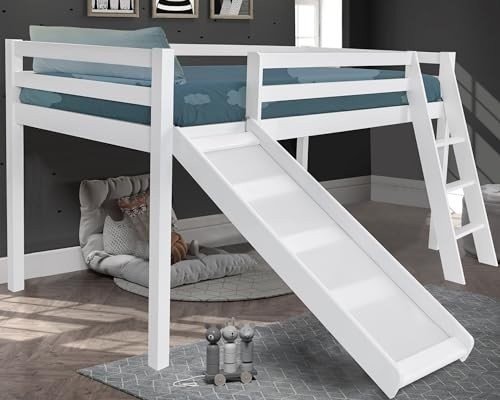Bunk Beds for Kids: A Comprehensive Guide
Bunk beds have been a popular option for children's bedrooms for many years. They offer a space-saving service that makes the most of floor location, provides fun climbing up alternatives, and is available in a range of designs that attract kids's imaginations. This short article explores the advantages, factors to consider, designs, and security functions connected with bunk beds for kids.
Benefits of Bunk Beds
Bunk beds present multiple advantages that make them an appealing alternative for households. Here are some crucial benefits:
Space Saving
- Bunk beds allow 2 or more kids to share a space without sacrificing space for play or other activities.
Cost-Effective
- Buying a single bunk bed can be more affordable than purchasing two different beds.
Fun Factor
- Kids typically see bunk beds as a fun place to sleep and play, cultivating a sense of experience.
Adaptability
- Bunk beds are available in numerous setups, consisting of L-shaped, loft beds, and even convertible styles that can alter as children grow.
Organization
- Many bunk beds include built-in storage alternatives, such as shelves and drawers, assisting keep rooms arranged.
Key Considerations Before Purchasing
Before purchasing a bunk bed, it's necessary to consider certain aspects, such as:
- Space Requirements
Measure the space to make sure that there is enough vertical space, enabling appropriate headroom on the top bunk. - Age of Your Children
Consider their age and maturity. Numerous makers recommend that children under six need to not sleep in the leading bunk due to safety issues. - Weight Limit
It's important to examine the weight limits of the bunk bed for both the top and bottom bunks to ensure security. - Style Preferences
Pick a style that matches the room's decor and the kids's preferences. - Material
Bunk beds are available in various materials, such as wood or metal. Each has its benefits and downsides concerning sturdiness and looks.
Designs of Bunk Beds
Bunk beds are available in numerous designs to fit different visual appeals and functional needs. Here's a list of some popular designs:
- Standard Bunk Beds
Classic stacked beds that include two beds built one above the other. - Loft Beds
A bed elevated high off the ground, with space underneath for a desk, play area, or storage. - L-Shaped Bunk Beds
2 beds arranged in an L-shape, supplying more flooring space and an unique style component. - Twin Over Full Bunk Beds
These options include a twin bed on the top and a full-sized bed on the bottom, accommodating older children or adults. - Triple Bunk Beds
Created for 3 kids, these beds normally consist of three stacked beds, suitable for bigger households.
Safety Features to Consider
Guaranteeing the security of children using bunk beds is critical. Here are some security features to look for before making a purchase:
- Guardrails
A bunk bed need to include durable guardrails on the leading bunk to avoid accidental falls. - Ladders
Guarantee that the ladder is securely connected and easy for children to browse safely. - Stability
Try to find bunk beds with lower centers of gravity and large bases to supply much better stability. - Quality Construction
Pick beds made from long lasting materials that meet safety requirements, such as ASTM (American Society for Testing and Materials) guidelines.
Frequently Asked Questions About Bunk Beds
1. What age is proper for a top bunk?Generally, kids aged 6 and older are suggested for oversleeping the leading bunk. 2. Are bunk Bunk Beds Cheap shariah.top for toddlers?Most specialists advise against
putting toddlers in the leading bunk due to the
threat of falls and incorrect ladder usage. 3. Can bunk beds be separated?Many bunk beds are created to be separated into two standalone beds,
providing added flexibility as children grow
. 4. How do I preserve a bunk bed?Regularly check for loose screws and wear, keep mattresses tidy, and guarantee that the bunk bed is
steady to extend its lifespan. 5.
Exist any unique mattress requirements for bunk beds?Yes, bed mattress for bunk beds need to fit snugly without leaving gaps. Generally, thinner mattresses
(around 6 to 8 inches )are recommended for top bunks for safety. Bunk beds offer a versatile, practical, and fun option for children's sleeping arrangements, optimizing space while accommodating several kids in one room. By considering the important elements
of style, safety, and space, parents can make an informed decision when choosing the right bunk bed for their kids's requirements. With the ideal care and upkeep, a bunk bed can be a beloved furniture piece that provides years of use and pleasure for kids. Summary Table of Bunk Bed Styles Style Description Best For Standard Bunk Beds Timeless style, 2 stacked beds Smaller sized rooms Loft Beds Raised bed with open space underneath Research study or play locations L-Shaped Bunk Beds 2 beds in an L-shape
Included floor space Twin Over Full Twin on the top,
| complete on bottom Accommodating older kids Triple | ||||||
|---|---|---|---|---|---|---|
| Bunk Beds | 3 stacked beds | Bigger families By comprehending | the various choices readily available, designated considerations for safety and functionality, and appropriate age guidelines, families | can choose the ideal bunk bed that not | only enhances their home | but likewise ensures a safe and |
| enjoyable sleeping environment | for their kids.

|
